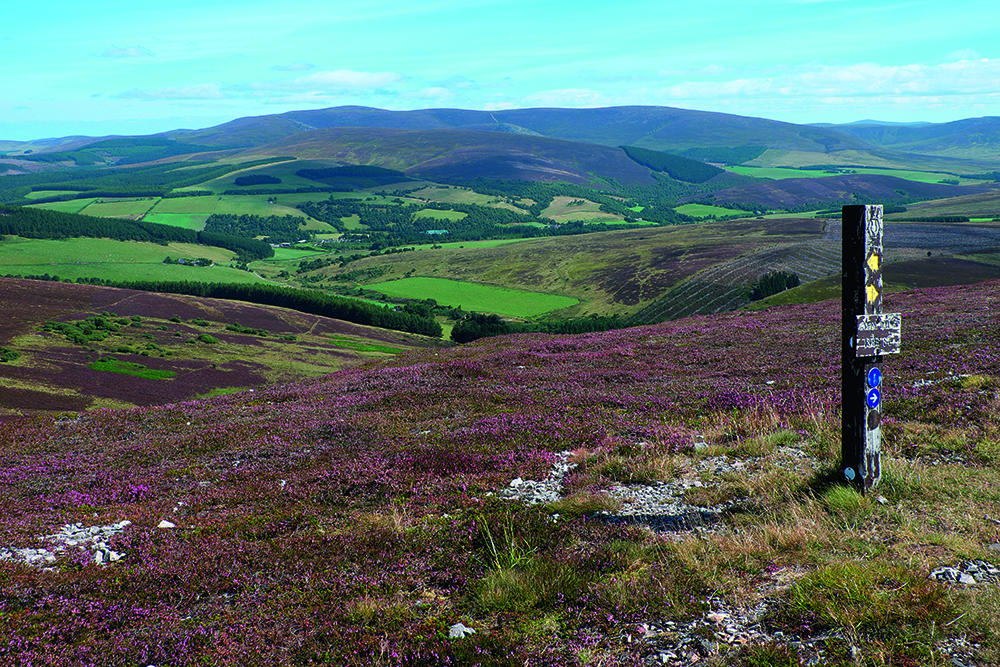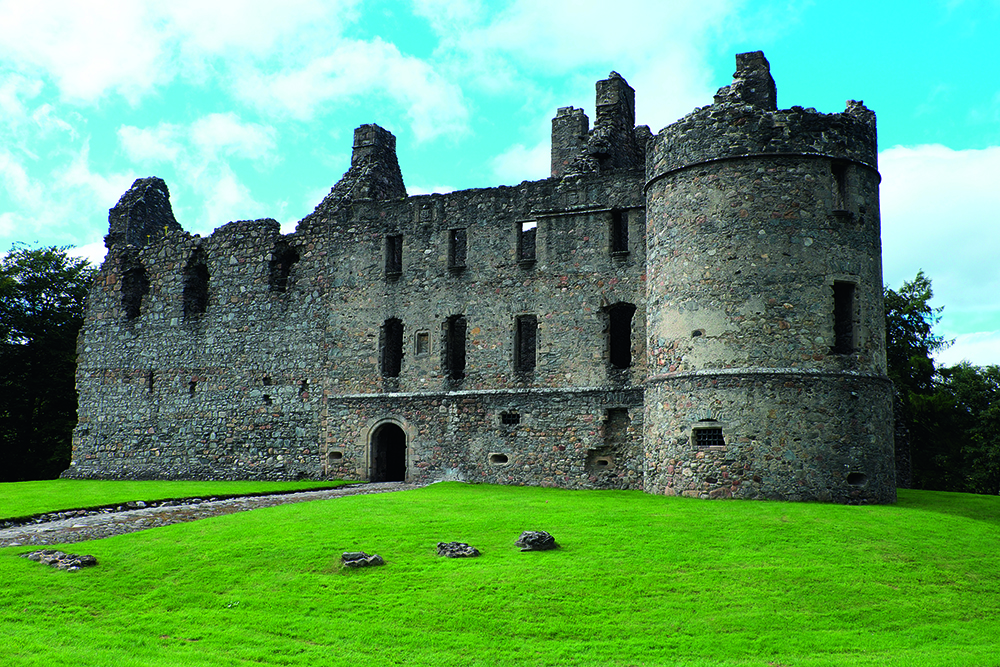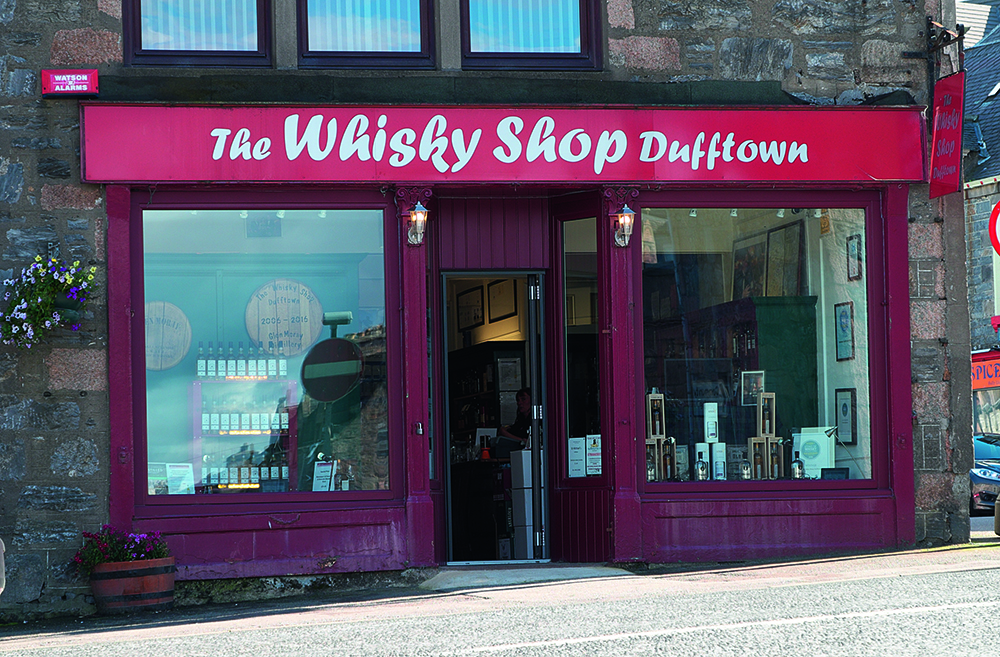Motorhome travel: Walking around Speyside
Cotton-wool clouds were kissing the rounded tops of the Cairngorms’ tundra-like summits far to the south while, closer in, it looked like an artist with an excess of purple paint had been hard at work on the heather moorlands of Glenlivet. We were standing on the 570m (1,870ft) Carn Daimh, admiring the views and trying to match up the toposcope with the various hills on the skyline.

We’d climbed the easy slopes of this heather-clad hill via one of Glenlivet’s excellent waymarked trails. Straddling the northern edge of the Cairngorms National Park in northeast Scotland, this 23,000-hectare estate is part of Crown Estate Scotland, owned by the Queen but managed by the Scottish government. It’s home to 20 waymarked walks, ranging from a half-hour stroll to a 12km (7½ miles) hill walk.
Each trail starts from a dedicated car park, where an information panel provides walk details, including the sort of terrain covered and guidance on where and when you’re most likely to encounter grouse shooters and deer stalkers. I love poring over maps, picturing the landscape and coming up with new walks, but it’s also great occasionally to come across places such as Glenlivet where I can switch off, tuck the map into my daypack and let the waymarkers lead the way.
Armed with detailed walk descriptions that we’d downloaded from the Glenlivet Estate website and encouraged by blue waymarker discs along the way, we did two of the routes during our trip to Speyside and Moray. And, not once did we get lost! The second walk led us into the Braes of Glenlivet, an isolated area dotted with lonely farmsteads and abandoned crofts. This secluded spot, overshadowed by the Ladder Hills, is also home to Scalan, a secret seminary where, in times of Catholic persecution, young men were prepared for the priesthood. Despite repeated attacks on the glen by the Redcoats during the eighteenth century, the so-called ‘heather priests’ who were trained here played a key role in keeping the banned Catholic faith alive in the Highlands.

We came across plenty of other reminders of history’s tumult scattered liberally throughout the Speyside landscape. In truth, I was in danger of becoming castled-out after climbing to the hilltop site of Drumin Castle, exploring the substantial remains of Dufftown’s Balvenie Castle and sitting out a rain shower amid the atmospheric ruins of forlorn Auchindoun Castle, perched on a ridge high above the River Fiddich. Just the thought of one more spiral stairway was starting to make me feel dizzy. But then we stumbled across Huntly Castle...
The skeleton of a once grand, palatial home, built by the Gordons in the sixteenth and early seventeenth centuries, dominates the site. The elaborate frontispiece, with its French influences, is seen as a bold statement of defiance by this Catholic family in post-Reformation times. The chisel marks of Presbyterian covenanters, who occupied the building in 1640 and set about erasing some of the Catholic imagery, can still be seen.
As well as four nights of ‘wild’ camping during our time in northeast Scotland, we also spent a night on a campsite in Aberlour, close to the banks of the River Spey. Just outside the village, Speyside Gardens Caravan Park is a peaceful site inside an old walled garden. Aberlour, or Charlestown of Aberlour to give it its full name, is where the famous Walkers shortbread is made.

It’s also in the heart of whisky country – nearby Dufftown is the self-proclaimed ‘malt whisky capital of the world’. There are dozens of distilleries within a half-hour drive of the village, including producers of some of the world’s most famous single malts such as Glenlivet and Glenfiddich. Many of these organise tours and a few also have cafés. If you’re a real enthusiast, you can even watch skilled coopers at the Speyside Cooperage near Aberlour making the oak casks in which the whisky is stored. The Spirit of Speyside Whisky Festival is held in early May, giving visitors the chance to attend whisky auctions, go on exclusive distillery tours and have tutored tastings.
Wildlife sightings included a couple of brown hares, a peregrine falcon and one red deer. The region is also home to red squirrels, ptarmigans, black grouse, mountain hares, golden eagles and otters as well as some rarer, more elusive characters such as wild cats and pine martens. Following the River Spey downstream, we headed north to the coast in the hope of spotting dolphins. The Moray Firth is home to one of the two largest populations of bottlenose dolphins in British waters; the other is in Wales.
At Spey Bay, where the river enters the sea, we found the Scottish Dolphin Centre, run by the Whale and Dolphin Conservation charity. The free visitor centre was full of families enjoying the informative displays. The centre offers a number of walks and tours, including an hourly land-based dolphin watch, twilight wildlife-watching walks and tours of the UK’s largest icehouse. Built in 1830, the latter formed part of the Tugnet fishing station. Ice blocks would be cut from the River Spey during the winter and placed in the ice house, most of which is underground. Salmon and other fish caught could then be kept fresh until it was ready to be shipped.
.jpg)
Further east along the coast, we called in at Cullen, the birthplace of Cullen skink, a hearty soup of smoked haddock, potatoes, milk and onions. Every November in the royal burgh, competitors take part in the Cullen Skink World Championships, battling it out to have their soup named as the best on the planet.
As sea-kayakers brought their boats in for the night, we took an evening stroll around Seatown, the lower part of the settlement. Here, tiny fishermen’s cottages divided by narrow alleyways turn their gable ends to the sea, huddling together for shelter from winter storms. It’s a pretty spot, towered over by an imposing eight-arch viaduct that once carried trains on the Elgin-to-Aberdeen line; today it carries cyclists and walkers.
Further east still, and just over the border in Aberdeenshire, we stumbled across the sort of place that, if it were further south, would be overrun with tourists. As it is, though, Findlater seemed to be the haunt solely of local dog walkers and young couples out for a romantic – and slightly adventurous – stroll. Having seen a coastal castle marked on the Ordnance Survey map, we left the campervan in the large parking area beside the Barnyards of Findlater and walked down to the cliffs.
En route, we paid a visit to the sixteenth-century Findlater Doocot (or dovecote). Stepping inside the beehive-style building, restored in 1992, the pile of feathers and guano on the floor suggested that birds still visit. Findlater Castle itself sits on a promontory connected to the cliffs by only a narrow strip of land. With strong gusts blowing from time to time and the grass greasy from the last shower, I didn’t fancy the crossing.
From the castle, clifftop paths head east towards Sandend and west towards Cullen. We couldn’t decide which way to go, so did a little of both. On our westward journey, we dropped to the hidden beach at Sunnyside. Another case of the dry Scottish sense of humour, perhaps in naming a north-facing beach Sunnyside? But there was no denying the beauty of this sandy bay, sheltered from the prevailing winds by cliffs and rocky headlands.
A walker, accompanied by a lively 14-month-old golden retriever called Bonny, was as enthused by the location as we were – despite being a regular visitor. “My friends think this is too far to walk with their dogs, but they don’t know what they’re missing. Just look at it!” Realising we were holidaymakers, she then reeled off a list of other walks we could do in the area. The Bin of Cullen, the Giant’s Steps, Crannoch Wood... We explained we were heading back home the following day. “You’ll have to come back then, won’t you?” she said. I told her we probably would and immediately started planning another trip in my head. We could head north from Aberdeen and work our way round to Inverness. Or we could start further south, in Stonehaven, perhaps, or Montrose, or even Dundee...






.jpg)


Recent Updates
Engine management lights: all you need to know
What is the engine management light? What does it mean, and what do I have to do? ...
Motorhome air suspension: all you need to know
Motorhomes are heavy and the additional weight of equipment and height of the bodywork can increase the loads ...
Motorhome WiFi: how to get better motorhome internet
Staying connected on the move is more and more essential, so relying on campsite WiFi isn't an option – here ...
A class of their own - our guide to A-class motorhomes
Thinking of trading up to an A-class, or even going straight to the top of the motorhome tree? We guide you ...
Explore overseas on a motorhome dream tour
Enjoy exotic travel in a campervan or motorhome by hiring, swapping with someone else or exporting your ...
Motorhome water systems: everything you need to know
On-board water is an important part of every motorhome – here’s everything you need to know ...
Campervanning in Europe: what you need to know
Whether you're planning a leisurely drive through the French countryside, navigating bustling city streets in ...
Campervan security: all you need to know
With thefts on the increase, it’s important to know how to keep your campervan secure and prevent campervan ...
Campervan furniture: everything you need to know
Our campervan experts guide you through all the essentials for your campervan, including tables, chairs, ...
Campervan finance: how to fund your purchase
Here we look at the different types of campervan finance available, to help you decide what’s the best option ...
Other Articles
Britain’s best used motorhomes
Want a great motorhome without paying the premium for a new one? Here's a guide to the best you can get in the pre-owned market for each layout, ...
Which motorhome? Choosing the perfect motorhome for you
Choosing a motorhome or campervan is one of the biggest buying decisions you’ll ever make, so it's important ...
Campervan washroom essentials: stay fresh on the road
Our guide will take you through the campervan washroom essentials you'll need so you're well-prepared for ...
Dogs in campervans: all you need to know
Follow our advice and your dog will enjoy campervanning as much as you do ...
Electric campervans: all you need to know
Our guide will take you through everything you need to know about electric campervans and what the future ...
Motorhome electrics: a complete guide to your motorhome electrical set-up
Motorhome electrics can dramatically enhance the convenience and comfort of your vehicle – but they can be ...
Lighting for campervans: all you need to know
We guide you through all the lighting options available for you and your campervan, including interior ...
Electric bikes for motorhomes: our ultimate guide
Read our comprehensive guide to electric bikes for motorhome owners, helping you add electric power to your ...
Our guide to 'cheap' motorhomes in 2024
If you're on the hunt for an affordable new motorhome, this is the best place to start – we've rounded up a ...
Campervans in winter: all you need to know
Here's your guide to preparing your campervan for the colder months, whether you will be using it or putting ...